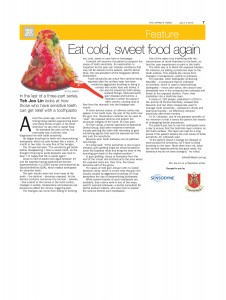 This article first appeared in the July 5, 2012 issue of the Straits Times. We have reproduced it for the information of those of you who missed it when it was published.
This article first appeared in the July 5, 2012 issue of the Straits Times. We have reproduced it for the information of those of you who missed it when it was published.
About five years ago, civil servant Chai Chong Hong started experiencing short and sharp busts of pain in his teeth whenever he ate cold or sweet food.
He tolerated the pain at first, but eventually saw a dentist, who diagnosed him with tooth sensitivity.
He began brushing his teeth with desensitising toothpaste, which he said worked like a charm. A month or two later, he was free of the twinges.
The 37-year-old said: “The sensitivity got better before disappearing. I have a sweet tooth, so the thought of having to avoid desserts was hard to bear. I’m happy that life is sweet again.”
Close to half of adults here aged between 15 and 64 reported having experienced dentine hypersensitivity in a 2010 survey commissioned by GlaxoSmithKline (GSK), which makes toothpaste for sensitive teeth.
The pain results when the inner layer of the tooth – the dentine – becomes exposed. As the dentine contains numerous tiny tunnels – tubules – that extend to the nerves in the tooth centre, changes in acidity, temperature and pressure are believed to affect the nerves, trigerring pain.
The changes can come from eating or drinking hot, cold, sweet or sour food or beverages.
A dentist will examine his patient to pinpoint the cause of tooth sensitivity. An examination is important as the pain can indicate conditions that may not be obvious to the patient, said Dr Kelvin Chye, the vice-president of the Singapore Dental Association.
Tooth sensitivity can result from dentine being exposed after the surface layer has been eroded by agressive brushing or being in contact with acidic food and drinks. It can also be caused by tooth decay, cracked fillings, fractured teeth, gum disease and bulimia, a disorder in which the patient often vomits, causing acid to flow from the stomach into the foodpipe and mouth.
In more serious cases, an obvious cavity may appear in the tooth neck, the part of the tooth near the gum line. Restorative material can be used to “seal” the exposed dentine and protect the structural integrity of the tooth, Dr Chye said.
Dr Elvin Leong, a dental specialist at Specialist Dental Group, said other treatment methods include painting the teeth with varnishes or gels containing agents that seal the exposed dentine and curb the sensitivity.
Severely worn tooth surfaces can be patched with fillings.
Dr Leong said: “If the sensitivity is due to gum disease, gum grafting might be recommended to cover the exposed roots and bring the level of the receding gum back to the original position.”
In gum grafting, tissue is harvested from the roof of the mouth and stitched onto the area where the exposed roots are. Over time, the tissue becomes part of the gums.
For cases of mild gum erosion with no visible abrasion cavity, which is a hole near the gum line usually caused by aggressive brushing, Dr Chye prescribes the use of desensitising toothpaste.
While several brands of such toothpaste are available, they mainly work in one of two ways, said Dr Leonard Litkowski, a dental consultant for dental product makers, who was here to explain the science behind such toothpaste.
One of the ways is by interfering with the transmission of nerve impulses to the brain, so that the user experiences no pain in the tooth.
The other way is to block the exposed tubules, for instance, by adding a protective layer to the tooth surface. This shields the nerves from changes in temperature, acidity or pressure.
For example, when toothpaste containing NovaMin – a compound that Dr Litkowski co-invented, which is used in desensitising toothpaste – mixes with saliva, the calcium and phosphate ions in the compound are released and drawn to the exposed dentine. There, they crystallise into a tooth-like layer.
A study on 120 people, published in 2010 in the Journal Of Clinical Dentistry, showed that Novamin and two other compounds used to manage tooth sensitivity – potassium nitrate and stannous fluoride – all effectively reduced sensitivity after three months.
To Dr Litkowski, one of the greatest benefits of his invention is that it saves the patient the hassle of undergoing dental procedures.
The patient just has to use the toothpaste twice a day to ensure that the tooth-like layer remains on the tooth surface. This layer can last for a long period if the patient tackles the root cause of tooth sensitivity, Dr Litkowski said.
“If the patient doesn’t change his lifestyle or what cause the sensitivity, he’ll have to keep brushing on the layer. More often than not, when the dentine hypersensitivity has gone away, the behaviour would not have changed,” he noted.
Source: Straits Times © Singapore Press Holdings Limited. Reproduced with permission





